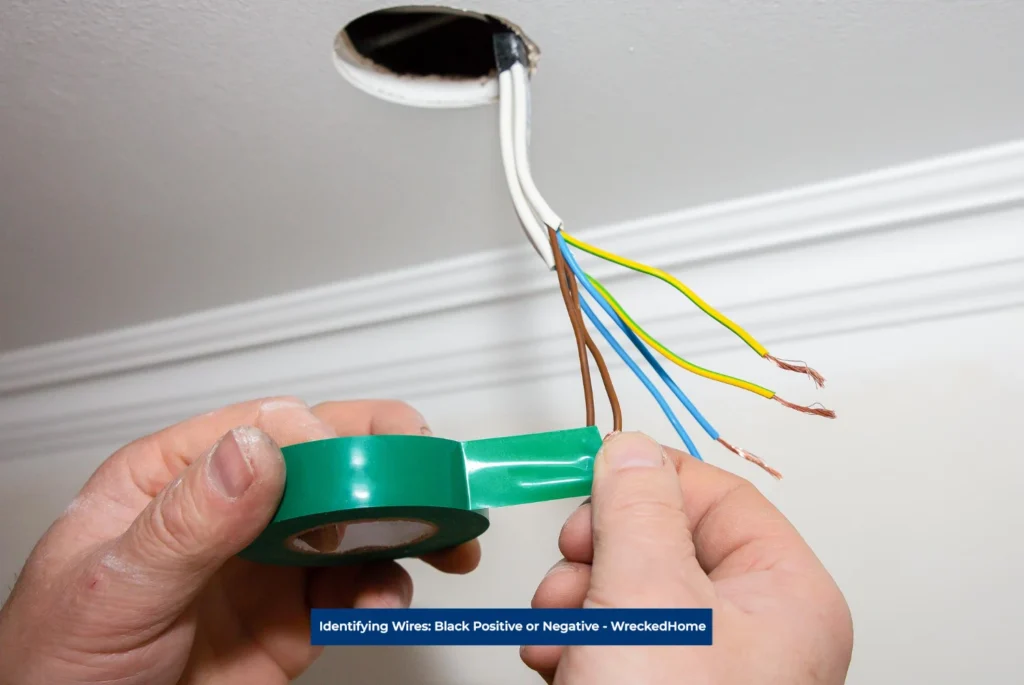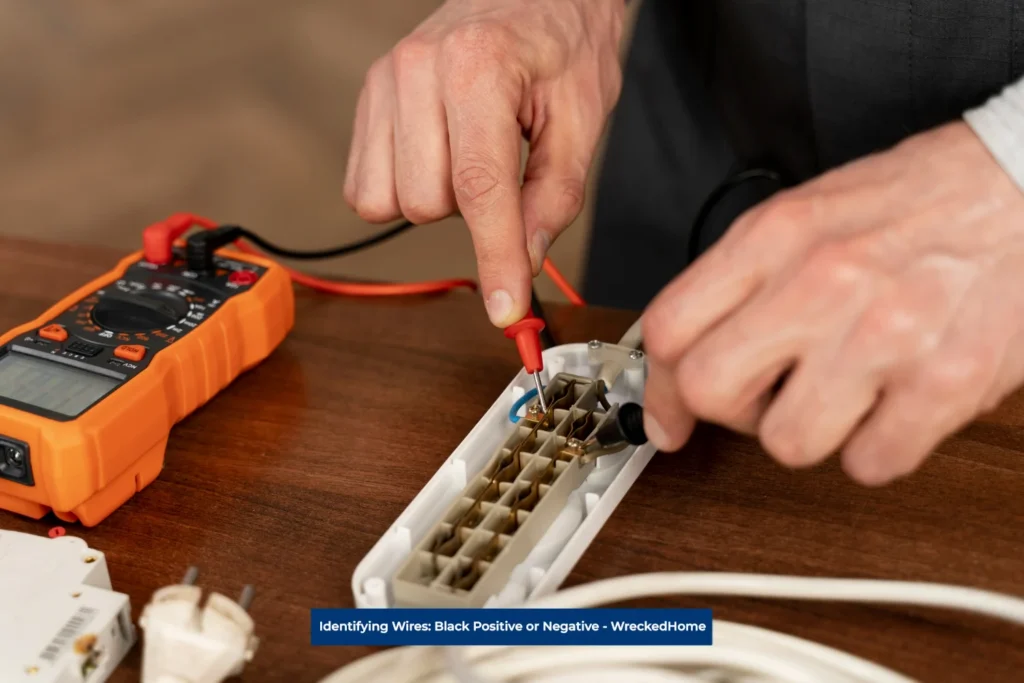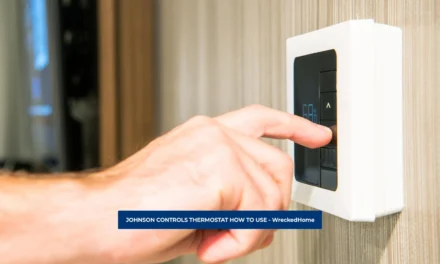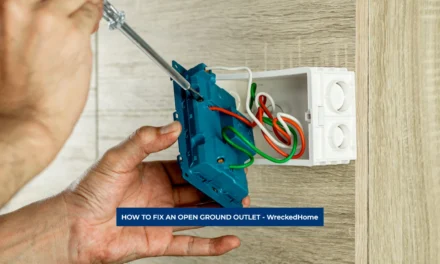Identifying wires is no less than a nightmare for individuals who have no electrical or professional experience. If you are installing a switch or updating light fixtures, it is imperative that you understand how to identify wires. More specifically, it is important that you understand the concept of identifying black positive or negative.
- Safety
- Identification
- Understanding the Black Positive or Negative Wire:
- Ways to identify Black Positive or Negative Wires:
- Why is Black sometimes positive but in other cases Negative?
- 3-Phase Wire Color Codes (USA)
- Coded Wires and Identification:
- Identifying the hot wire in cases of the same color:
- Final Remarks:
Safety

Although this is a teaching experience, we also want to ensure your safety while you complete your next project. You must follow all the precautions before working on any electrical projects.
Doing so will help you in many ways. You can ensure your safety, the project’s success, and productivity. Meanwhile, while working with wires, you save much time by having a prior idea of identifying wires. Plus, you avoid all sorts of unexpected injuries while working with switches.
Identification

In order to be safe, we should not deny the process of wire identification. You can start with an easy way of labeling the wires. As a result, it becomes easier to identify wires.
There is some color coding to help, but the experts don’t recommend solely relying on that unless you are an expert or are sure about it. Using a micrometer would be a better option to identify the black positive or negative wire.
If we look at the DC and AC circuits, the term used for the black wire is hot or active wire. However, it becomes difficult to identify the black positive or negative wires. But, you can say that, on average, the AC circuit’s black wire is hot or live. But, if it is in the DC circuits, the black is negative with red positive.
Understanding the Black Positive or Negative Wire:
In cases where you have stripes and dashes on the wire, it becomes more challenging to identify the positive or negative wire. Now, the answer is dependable on the marking of the wire. You can consider an unmarked wire as negative wire.
It is necessary to know when you are starting a home electrical project. You should know how to identify wires when working with electricity. Therefore, we advise you to do thorough research before starting the project.
Ways to identify Black Positive or Negative Wires:
We will present some tips to help you identify the black positive or negative. Next time you start a DIY project or anything related to wires. You can differentiate the black positive or negativein a matter of seconds.
However, micrometers can help you in the process. The white wire receives the excess electricity. If you lack proper wiring, you may risk the circuit to malfunctioning. It also makes the system prone to electric shocks. Electric Wires, if not handled properly, are prone to risk and danger. Working with electrical wires is no joke.
Many people wonder if the wire is a black positive or negative wire. However, the answer is not as transparent as you think. Sometimes, it can be either negative or positive. When not sure, it is better to ask for help from licensed electricians.
Why is Black sometimes positive but in other cases Negative?
Black wire shows polarity in electrical wiring. When you install or repair an electricalwire, the black is usually connected to the negative terminal. It is, therefore, necessary to rely on color coding. You can save a lot of time and prevent injuries.
However, in specific cases, the black wire can be positive as well. It depends on the industry where you are using it. For example, the automotive industries mostly use black as positive. However, this is not the case normally. There are some other alternate ways of using the black wires in different industries. I encourage everyone to learn the color coding system and then identify various wires. But, if you fail to do so, you can ask the experts who know much more about this particular field.
You may refer to the table below for a quick guide. It tells you how you can identify the wires based on color coding;
- Black Wire: it is a color that indicates a hot wire that carries electricity. You can shut the breaker off when you work with black wires.
- Red Wire: this is an indication of a secondary hot wire. It interconnects smoke detectors and power outlets. Meanwhile, you have to be careful while dealing with this wire.
- White or Gray Wire: they are neutral wires that are responsible for carrying power back to the breaker box.
- Green Wire: the green wire is your grounded wire. Yes, it grounds the entire circuit and reduced the overload.
- Copper Wire: it is also a ground wire and provides path to the current in case of short out or tripping.
- Blue and Yellow Wires: this color indicates a hot wire. Present in the conduit to plus electrical device, these wires allow operation of the appliances.
So, follow these basic color coding and identify their functions. Please don’t forget to take safety measures before working with electronic devices.
3-Phase Wire Color Codes (USA)
If you’re adding an appliance or machinery, study the color codes. The color-coded wire takes power from a circuit to the end device.
AC Powers: (Homes and Offices; 120, 208 or 240 Volts).
| Phase One | Black Wire |
| Phase Two | Red Wire |
| Phase Three | Blue Wire |
| Neutral | White Wire |
| Ground | Green, Green with a Yellow Stripe, or Bare Wire |
Industrial Equipment: Industrial equipment: 277 or 480 Volts
| Phase one | Brown Wire |
| Phase Two | Orange Wire |
| Phase Three | Yellow Wire |
| Neutral | Gray Wire |
| Ground | Green, green with yellow stripe, or bare wire |
Direct Power (cell phones, flashlights, cars and solar panels)
| Positive | Red Wire |
| Negative | Black Wire |
| Ground | White/Gray Wire |
Coded Wires and Identification:
As a layman, it becomes daunting to work with wires. How would one identify the wires and their polarity? Therefore, the color coding comes in the rescue to help you identify everything. You only have to be careful while working with black positive or negative electrical wire or wires in general.
You can now avoid the polarity confusion and identify the wire quickly. This is the reason why engineers learn about various color schemes. But, nowadays everybody takes interest in this topic. It is because they have to perform many DIY projects. Let us look at the benefit of color coding;
- It makes it easy for an average homeowner to understand the coloring and ensure their safety. They also learn identifying wires for their DIY projects or any electronic project.
- We mostly forget things we learn. But, the colors make things easier to remember. This visual representation of colors and their meanings remains in the memory for a long.
- Color provides you with a reliable and better system of identifying the wires. Even when you don’t know anything, you can still have a rough idea that black electricity represents a hot wire.
- When you use colored wires, you know which color wire to attach to the circuit. As a result, you don’t get overheated electrical appliances and wires. That saves much cost and prevents unwanted happenings.
- Likewise, the color makes it easy to work on various wires. The electrical engineers, contractors, and technicians know the wire’s role and functionality.
- The color is the best and only way to identify various wires. Hence, it becomes helpful to work with electrical stuff.
- It is also necessary in the field of electrical engineering. They need to understand the entire system. Plus, the color coding system is a well-known concept for them.
- It also aids you in tracing and replacing faulty wires.
- It is an essential part of the wire identification system, and you should remember it when you work on any project.
- You can avoid the potential costly mistakes when you rely on color coding.
In short, you can always use this color guide while working with wires. It allows you to remember that white is neutral and black is a hot wire. So, when you deal with them, you should know the specific meanings of each color. However, in some cases, blue can show negative polarity depending on the context and situation.
Visit our store for 10% off our Save Home Energy products here.
Identifying the hot wire in cases of the same color:
Have you ever thought about what if you get the same color wires? It is going to be a daunting task, especially for people who are not experts. They will have to identify the black positive or negative. They need to identify which wire carrying electricity from a breaker panel is the hot wire.
It is possible to differentiate between both wires by slightly touching their surface. For multi color wires, the cover helps you identify their polarity.
In addition, you can use a voltage meter to check the polarity. Other ways to identify the polarity are the continuity test and battery test. Then, you can identify the hot wires.
You can perform the continuity test by connecting wires to the ends of the circuit. The wire that has lower resistance is the hot one. In battery tests, connect both to the positive/negative battery terminals.
Likewise, in some specific cases, the black can indicates positive wiring. It is always wise to be sure before finally making any connections. You can get an experts’ help to be sure you are not ruining anything.
Final Remarks:
Identifying wires is necessary when you are doing any type of electrical work. However, this does not have to be difficult. There are some tests to help you. Voltage testing and continuity testing can help you to identify wires. You may also refer to the color coding to understand more. Thus, it becomes easy to identify the black positive or negative wire.
Note: ensure you turn the power off before starting any electrical project. Your safety is more important than anything else.
For any repairs, installations, builds, or questions; We recommend you to hire a professional. Find A Pro Near You Here!





































